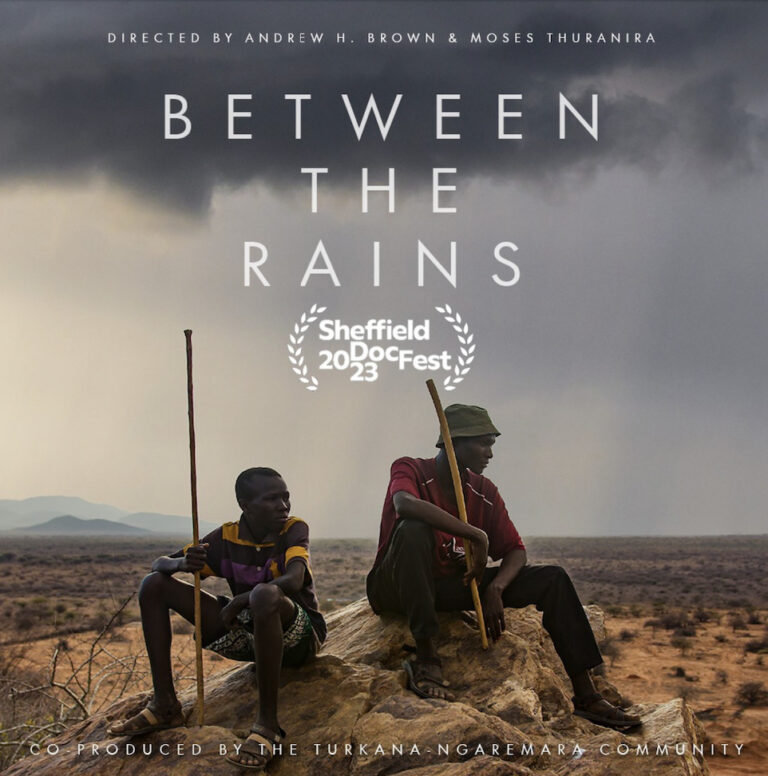
In 2019 Swedish teenager Greta Thunberg, one of the most influential voices on climate change, told the world leaders in a United Nation speech: “We will not let you get away with this. Right here, right now is where we draw the line. The world is waking up and change is coming, whether you like it or not”. But the change seems to be too late for the Turkana-Ngaremara people of north Kenya in Andrew H. Browns and Moses Thuraniras “Between the Rains”, a very worthy winner of best documentary at Tribeca Festival. Until recently, the nomadic people have always lived in harmony with nature. Radical climate changes with extreme drought are not only a present reality but threaten the core of their culture. In their fragile world, things are rapidly shifting in the dry gaps between the rain.
We meet Kole, a young, sensitive, orphaned “known as the boy who was born amongst the goats”. Working as a shepherd, he struggles with inner conflicts about his own identity and his purpose in life as neighboring tribes steal goats from one another, leading to bloodshed. In Kenya, communities depend upon grazing livestock, the main source of food and wealth, and the drought stirs ethnic fighting between tribes over scarce resources. The older men have already chosen Kole as a warrior. He says: “when the river is full, life is peaceful and without fear. But between the rains, the river dries and neighbors become enemies.”
But it is not people Kole is afraid of, it is nature. Nature makes you either a predator or prey. It is a vindictive beast and the only thing worthy of fear. Long before his nomadic people became locked in Kenya, they followed the rains and never settled too long to burden the land. Other tribes and British colonizers have tried to erase them, but they always survived.
Soon this land may become uninhabitable for humans. Nature is the only power that can destroy. It wasn’t always this angry at us, the elders say.
The heart of the film is gently powerful – humans must not upset nature. When nature is happy, humans live in peace without fear. The hypnotizing and striking cinematography, that also won the prize at Tribeca, captures the fragile beauty of Kenya; the pink evening horizon over the endless savannahs, the gigantic moon, the starry sky, the bird nests, the glowing fire, the spider in the net, the flying sand, and the proud Acacia trees. This unbelievable beauty contrasts sharply with the harsh reality of people’s lives.
We observe village elders read a goat’s intestines to learn when rain might return, or when they will be attacked. In a cruel traditional rite, teeth are pulled out with a spoon. Young men must show they are “real men” not cowards. The gunshots echo up in the sky. Besides Kole, we meet Veronica the aunt and Josephine the Turkana peacemaker. Only a glimpse of the sick grandmother is shown, a short time after she passes away. The older brother Patrick declares that it’s not good to have childish dreams when Kole wishes his path would lead to a different life.
Authenticity soaks the entire film which is seamlessly edited and stunningly intimate. It’s no wonder. “Between the Rains” was filmed over the course of four years and edited down from 800 hours of footage by a thoughtfully built and developed team. Three of the producers were born and raised in the region and they had close collaboration and bond with the Turkana-Ngaremara community.
Co-director Moses Thuranira comes from a neighboring community within the same region and has helped communities in Kenya’s northern region to have a voice his whole life. Co-director and DP Andrew H. Brown has been working in sub-Saharan Africa for the last decade – initially working with humanitarian and socioeconomic projects and later as a documentary filmmaker producing the great “When Lambs Become Lions” (2018), another Tribeca documentary winner taking place in Kenya. The producer Samuel Ekomol has lived in the Turkana pastoral village which they filmed in throughout his entire life and Naomi Kambura, also producer, is a member of the neighboring Samburu tribe and gives women voices. Their story, therefore, comes from a place that understands the sacrifices many East African communities are making in increasingly challenging climate times and how young people are caught within a traditional culture.
More than 23 million pastoralists, like Kole’s people, are currently facing extreme drought in East Africa due to climate change. Those who are one with nature, the most vulnerable, are affected the hardest. Let this documentary, one of the most vital and visual stunning of its kind, spread its wings around the world. What people in northern Kenya go through today is literally everybody’s concern.
Grade : A-

